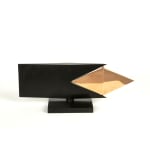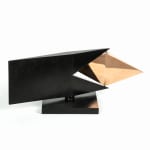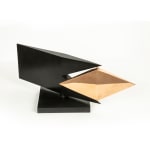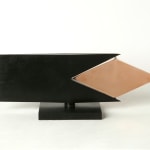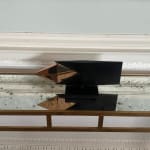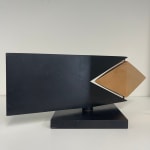Lynn Chadwick
Ace of Diamonds , circa 1980
signed and numbered C158B 7/20
bronze
9 cm high
Edition 7/20
Further images
Lynn Chadwick RA (1914-2003) never formally trained as a sculptor, and yet he became one of the 20th century’s best-known and recognisable artists, developing his own unique construction techniques. Although...
Lynn Chadwick RA (1914-2003) never formally trained as a sculptor, and yet he became one of the 20th century’s best-known and recognisable artists, developing his own unique construction techniques.
Although interested in art from an early age, Chadwick was encouraged by his teachers to pursue architecture as a more viable career. He subsequently trained as a draughtsman, before joining the Fleet Air Arm in 1941. Immediately after the war he began to venture further into the art world, making mobile constructions for building trade fairs and it was the resulting success of these early mobiles and stabiles, two of which were shown on the South Bank during the Festival of Britain in 1951, that first allowed him to seriously consider becoming a freelance sculptor. Chadwick’s unique approach was based on construction rather than modelling and first came to international prominence in 1952 when he was included in the British Council’s New Aspects of British Sculpture exhibition for the XXVI Venice Biennale alongside Kenneth Armitage, Reg Butler, Bernard Meadows, Geoffrey Clarke, Robert Adam, William Turnbull and Eduardo Paolozzi.
In 1953 Chadwick was one of the twelve semi-finalists for the Unknown Political Prisoner International Sculpture Competition and at the age of 42 just six years as a sculptor he was awarded the International Prize for sculpture at the 1956 Venice Biennale, beating the established favourite Alberto Giacometti. He was the youngest sculptor ever to receive the honour.
Many honours and awards followed this period and his work was widely collected both privately and by major institutions globally. In 1964, he was awarded a CBE and in 2001 was elected a Royal Academician. A major retrospective of his work was held at Tate Britain, London in 2003 - sadly Chadwick died just five months before it opened.
Throughout his career, Chadwick played with form and narrative, abstraction and naturalism and exploited this rich vein, producing many sculptures, well into the 1980’s. The ‘Ace of Diamonds’ series includes the dynamic of form and movement often implied in his static sculpture but here brought into reality, changing the interrelationship of the forms and their surroundings. The sculpture is split into two halves that seem so conjure up endless combinations of geometric effects. Such geometry forms were one of Chadwick's predilections since the 1970's. He was apt to refer to the pyramid or diamond shape as the feminine aspect, while masculinity was represented by the rectangular form.
Although interested in art from an early age, Chadwick was encouraged by his teachers to pursue architecture as a more viable career. He subsequently trained as a draughtsman, before joining the Fleet Air Arm in 1941. Immediately after the war he began to venture further into the art world, making mobile constructions for building trade fairs and it was the resulting success of these early mobiles and stabiles, two of which were shown on the South Bank during the Festival of Britain in 1951, that first allowed him to seriously consider becoming a freelance sculptor. Chadwick’s unique approach was based on construction rather than modelling and first came to international prominence in 1952 when he was included in the British Council’s New Aspects of British Sculpture exhibition for the XXVI Venice Biennale alongside Kenneth Armitage, Reg Butler, Bernard Meadows, Geoffrey Clarke, Robert Adam, William Turnbull and Eduardo Paolozzi.
In 1953 Chadwick was one of the twelve semi-finalists for the Unknown Political Prisoner International Sculpture Competition and at the age of 42 just six years as a sculptor he was awarded the International Prize for sculpture at the 1956 Venice Biennale, beating the established favourite Alberto Giacometti. He was the youngest sculptor ever to receive the honour.
Many honours and awards followed this period and his work was widely collected both privately and by major institutions globally. In 1964, he was awarded a CBE and in 2001 was elected a Royal Academician. A major retrospective of his work was held at Tate Britain, London in 2003 - sadly Chadwick died just five months before it opened.
Throughout his career, Chadwick played with form and narrative, abstraction and naturalism and exploited this rich vein, producing many sculptures, well into the 1980’s. The ‘Ace of Diamonds’ series includes the dynamic of form and movement often implied in his static sculpture but here brought into reality, changing the interrelationship of the forms and their surroundings. The sculpture is split into two halves that seem so conjure up endless combinations of geometric effects. Such geometry forms were one of Chadwick's predilections since the 1970's. He was apt to refer to the pyramid or diamond shape as the feminine aspect, while masculinity was represented by the rectangular form.
Provenance
The artistPrivate Collection UK, gifted by the artist and his wife as a wedding present to her goddaughter.
Courtesy of Zuleika Gallery
Copyright The Artist







